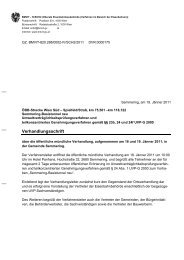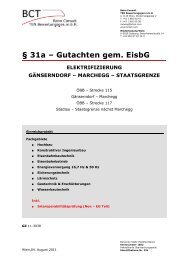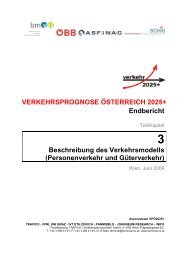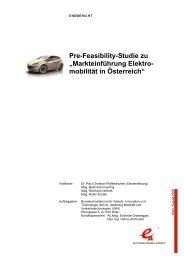Schriftenreihe .;technologiekompetenz Verkehr in
Schriftenreihe .;technologiekompetenz Verkehr in
Schriftenreihe .;technologiekompetenz Verkehr in
Create successful ePaper yourself
Turn your PDF publications into a flip-book with our unique Google optimized e-Paper software.
CONTROL<br />
In the first <strong>in</strong>stance, the control of the electric drive adjusts the<br />
speed and torque of the electric motor. The control system has<br />
to be chosen and developed with regard to the design of the<br />
drive, the mach<strong>in</strong>e type and correspond<strong>in</strong>g power electronics.<br />
Usually this control system uses cascade structures to perform<br />
different tasks, like current control or speed control. The<br />
performance of modern digital signal processors and their<br />
<strong>in</strong>telligent programm<strong>in</strong>g allows them to be employed as a<br />
multitask<strong>in</strong>g operat<strong>in</strong>g system to implement sophisticated<br />
control structures.<br />
Besides time-critical tasks (such as controll<strong>in</strong>g the semiconductor<br />
valves for the power electronics), the control parameters of the<br />
electric drive can be monitored and adapted cont<strong>in</strong>uously. In this<br />
way the <strong>in</strong>fluences of temperature or different loads on the<br />
drivetra<strong>in</strong> can be compensated. By adapt<strong>in</strong>g the control<br />
parameters, the entire drive can be operated at a predef<strong>in</strong>ed<br />
optimum.<br />
Additional tasks which the signal processor can perform us<strong>in</strong>g<br />
appropriate algorithms <strong>in</strong>clude: diagnos<strong>in</strong>g the status of the<br />
electric mach<strong>in</strong>e, sensorless control of the mach<strong>in</strong>e, and<br />
handl<strong>in</strong>g communications between the electric drive and the<br />
vehicle’s energy management system. The basis for<br />
programm<strong>in</strong>g the signal processor is the mathematical modell<strong>in</strong>g<br />
of the drivetra<strong>in</strong> components. Appropriate simulation tools<br />
support this development and optimisation process, reduc<strong>in</strong>g<br />
the expenditure required to implement the mathematical models<br />
as executable codes. Sophisticated modell<strong>in</strong>g of the drivetra<strong>in</strong><br />
components is therefore required to realise real-time enabled<br />
models with an appropriate level of detail.<br />
ELECTRIC DRIVES<br />
Besides consider<strong>in</strong>g and optimis<strong>in</strong>g these electric drive<br />
components, attention also needs to be given to how the entire<br />
electric drive (compris<strong>in</strong>g the electrical energy storage, the<br />
power electronics, and the electric motor) is <strong>in</strong>terconnected. The<br />
cabl<strong>in</strong>g of the components has to be kept as short as possible<br />
to prevent additional losses. Development efforts therefore<br />
need to focus on strong <strong>in</strong>tegration of the electric mach<strong>in</strong>e and<br />
the power electronics.<br />
In addition, high-voltage concepts are needed to provide the<br />
power for electric propulsion without high losses and weight.<br />
Us<strong>in</strong>g high voltage consequently raises safety issues and<br />
requires appropriate safety concepts, supported by highly<br />
<strong>in</strong>tegrated electric drivetra<strong>in</strong> components.<br />
Summariz<strong>in</strong>g the key issues of electric drive development for<br />
automotive applications, <strong>in</strong>cludes consideration of the electric<br />
components with<strong>in</strong> the context of the given vehicle concept, the<br />
optimisation of the components with<strong>in</strong> with the given system<br />
and the use of the latest materials, technologies and<br />
development tools.<br />
33

















